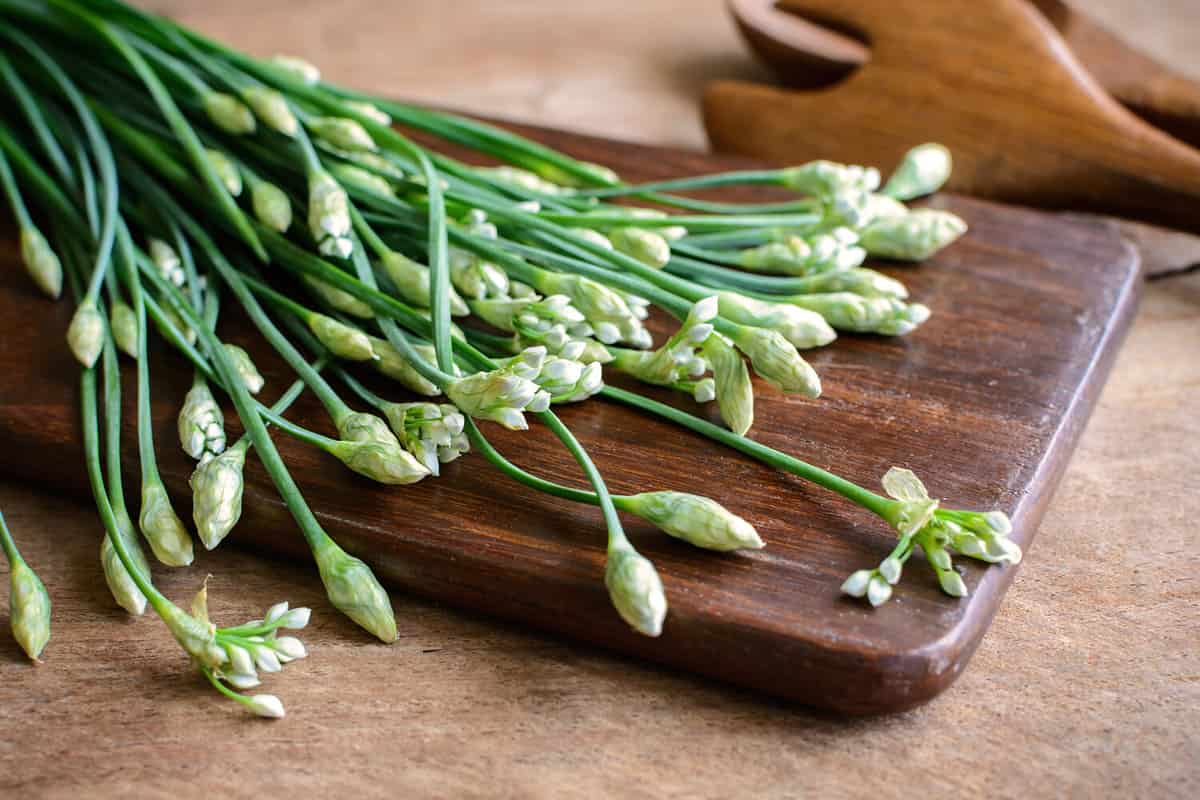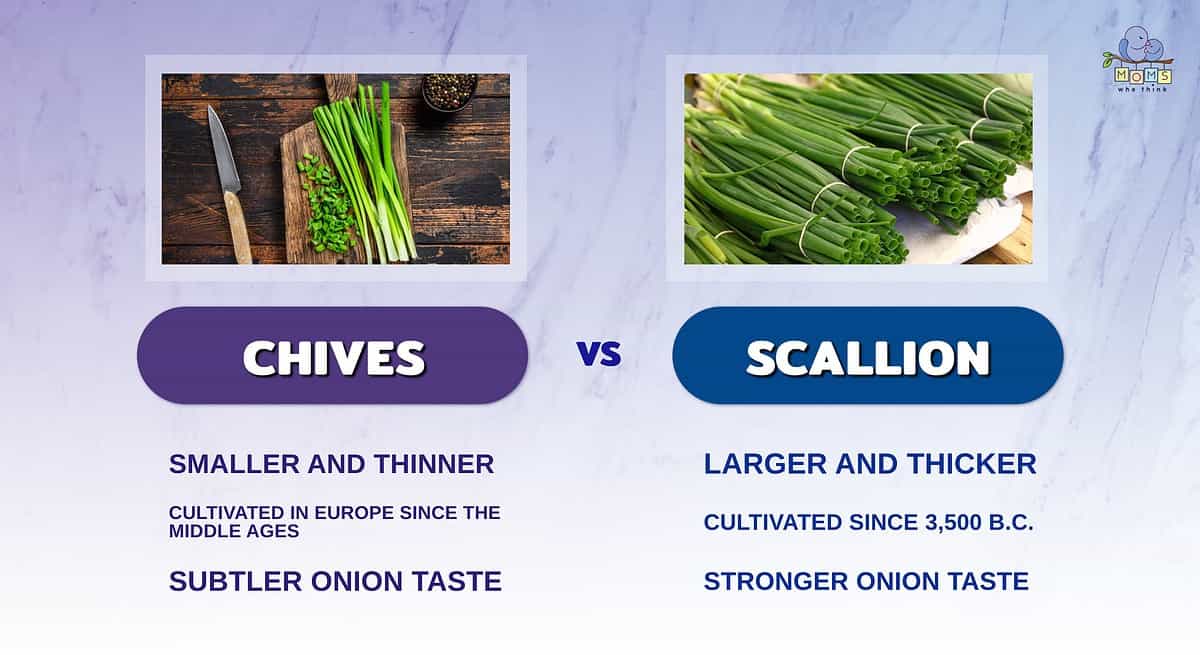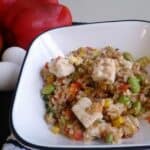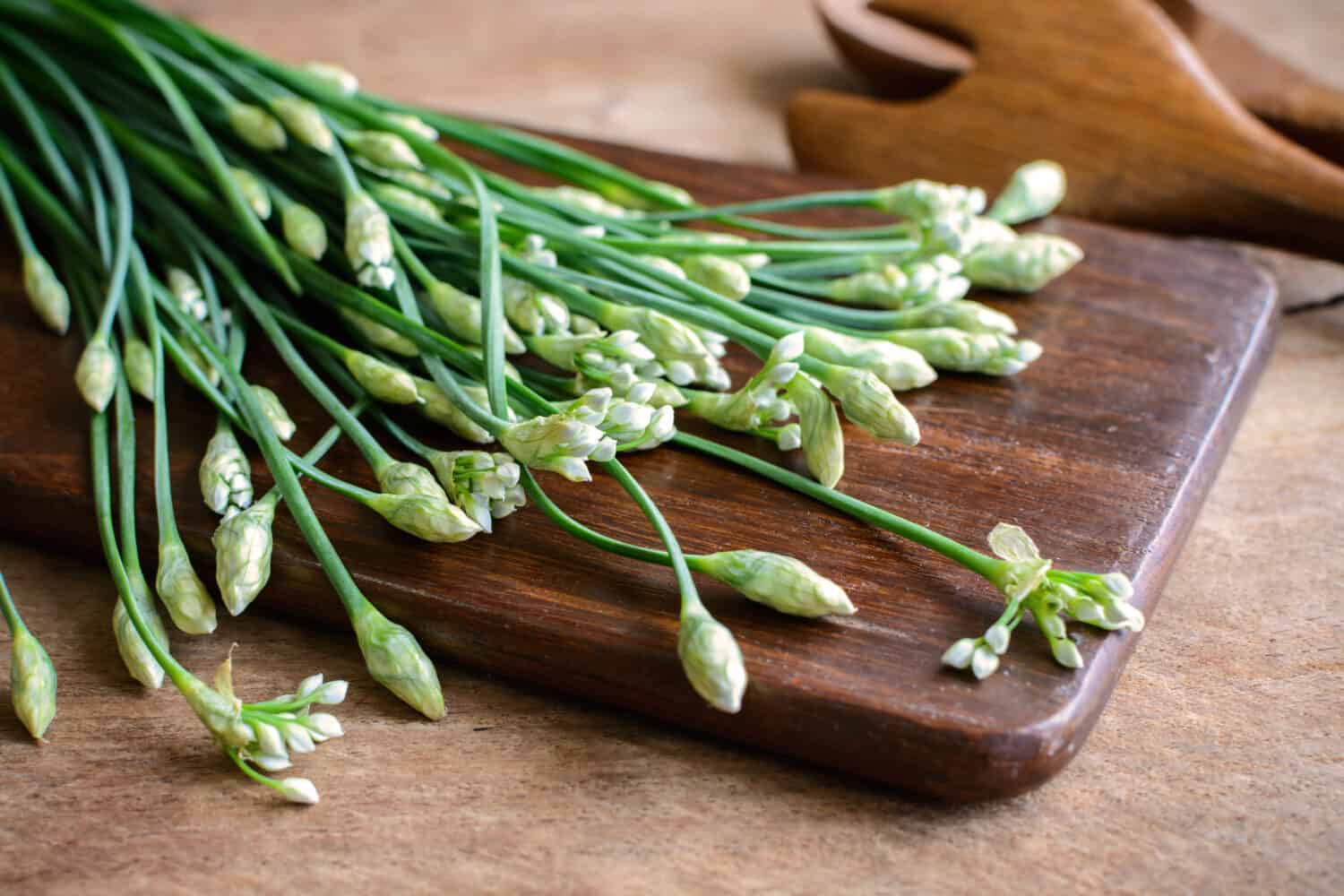Chives vs. Scallions: What makes them different? One of the commonalities is that they both have an onion flavor. However, there are noticeable differences that make them unique. For instance, chives are smaller and thinner. They are also easier to break because they are more delicate. Even so, chives are a great substitute for scallions. And scallions are a great substitute for chives. They also have a unique history and how they were used in different cultures dating back thousands of years.
In this guide, we look at some similarities and differences between chives and scallions. We show you the history behind chives and scallions, why they taste different, and how to cook with them. By the end, you'll better understand how to use both and why they stand alone when making your favorite recipes.
What Makes Chives and Scallions Different?

Chives and scallions share noticeable differences that can be easy to miss.
©kitzcorner/Shutterstock.com
Chives and scallions have a long, rich history, both thousands of years old. For example, chives have been cultivated in Europe since the Middle Ages, while scallions have been cultivated since 3,500 B.C. They are also native to Asia.
Looking more at the history between these two plants can give you insight into how different cultures used them. You'll have a deeper appreciation of how chives and scallions have helped shape what cultures eat and what medicines they produce.
The History of Chives vs. Scallions:
Chives are around 4,000 years old. The Chinese harvested them to produce different medical treatments or for culinary purposes. The Romans used chives to relieve sunburn or remedy a sore throat. Today, chives are less used for medical purposes. They are more used for culinary purposes.
Another interesting fact about chives is that there are four different kinds of specifies.
- Common Chives
- Garlic Chives
- Giant Siberian Chives
- Siberian Garlic Chives
Depending on the climate of where you live, you can grow chives in your backyard. If you grow common chives, you'll notice they are different from others because they have hollow leaves. They also have clusters and purpose flowers. They also have a slight onion flavor, which makes them similar to scallions.
Garlic Chives are sometimes referred to as Chinese chives. They tend to taste more garlicky and are often used in Chinese cooking. Giant Siberian Chives are as their name implies. They are giant, with leaves growing to nearly 25 inches. Lastly, the Siberian Garlic Chives come from Siberia and don't taste too garlicky. The flowers are rosy violet and are known for ornaments.
Scallions have a different history than chives. Scallions were one of the earliest cultivated crops. Some argue that any onion before the bulb widens is a scallion. Some will argue that green onions are the same as scallions. However, it's still up for debate.
Scallions are prominent throughout the world but originally come from Asia. They were also used as medicine, specifically for cleaning wounds. You could also eat them regularly to support your immune system as well as your urinary system.
However, the biggest difference in chives and scallions is how they are today in recipes.
Taste Differences and Recipes to Consider
While scallions and chives have a different history, they can be used interchangeably in recipes. Since they taste onion, you can swap them out without drastically affecting your cooking. However, the only difference you may notice is the texture since scallions are thicker and bigger. Another noticeable difference is that scallions have a stronger onion taste than chives. While chives still have an onion taste, it has more of a mild, herbaceous flavor.
Here are some of the most common recipes you can cook with scallions.
- Chinese Scallion Pancakes
- Creamy Scallion Soup
- Baked Scallion Bread
- Ginger Scallion Noodles
- Stir-Fried Chicken With Noodles
- Fried Rice With Scallions
Here are some of the best recipes you can cook with chives.
- Garlic Chive Stirfry With Pork
- Korean Chive Pancakes
- Creamy Chive Soup
- Chive and Parsley Pesto
- Parmesan and Chive French Toast
Chives vs. Scallions: What Should You Use for a Recipe?

- Chives are smaller and thinner than scallions.
- While chives are quite old, they have only been cultivated in Europe since the Middle Ages. Scallions, on the other hand, have been cultivated since 3,500 B.C.
- Scallions have a stronger onion taste, an important note to make when considering which you want for a recipe.
Swapping out chives for scallions or scallions for chives has been done hundreds to thousands of times in recipes. While they are slightly different in texture and taste, the difference is marginal. Either of these plants offers a lot of recipe ideas that you can try to make a delicious meal.
It's important to remember that scallions have a slightly stronger onion taste. Whatever you're making, you may want a less distinct or more distinct onion flavor. Ultimately, you'll discover that chives and scallions are the best plants for cooking your favorite dishes.
Print
Fried Rice with Scallions, Edamame, and Tofu
- Yield: 4 servings
Ingredients
- 1 tablespoon plus 1 teaspoon canola oil
- 2 large cloves garlic, minced (about 2 teaspoons)
- 4 scallions (white and green parts), thinly sliced
- 1 tablespoon peeled and minced fresh ginger
- 4 cups cooked brown rice
- 3/4 cup seeded and finely diced red bell pepper
- 3/4 cup frozen shelled edamame, cooked according to package directions and drained
- 1/2 cup fresh or frozen (thawed) corn kernels
- 6 ounces firm tofu, cut into 1/4-inch cubes
- 2 large eggs, beaten
- 3 tablespoons low-sodium soy sauce
Instructions
- Heat 1 tablespoon of the oil in a wok or large skillet over high heat until very hot but not smoking. Add the garlic, scallions, and ginger and cook, stirring, until softened and aromatic, 1 to 2 minutes. Add the rice, red pepper, edamame, corn, and tofu and cook, stirring, until heated through, about 5 minutes.
- Make a 3-inch well in the center of the rice mixture. Add the remaining 1 teaspoon oil, then add the eggs and cook until nearly fully scrambled. Stir the eggs into the rice mixture, then add the soy sauce and incorporate thoroughly. Serve hot.
Nutrition
- Serving Size: about 1½ cups
- Calories: 400
- Sodium: 465mg
- Fat: 12.5g
- Saturated Fat: 2g
- Carbohydrates: 56g
- Fiber: 7g
- Protein: 16.5g
- Cholesterol: 106mg
The image featured at the top of this post is ©kitzcorner/Shutterstock.com


